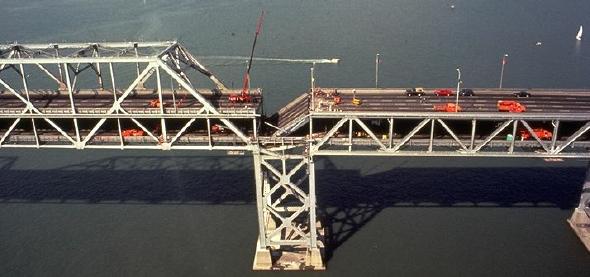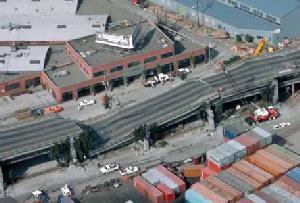
Claim: After the 1989 Loma Prieta earthquake, a car thief was found crushed to death under a collapsed freeway overpass in the vehicle he'd stolen.
Examples:
[Collected on the Internet, 1994]
A man by the name of Jones purchased his dream car on
[Collected on the Internet, 1990]
This sounds like an urban myth, but I trust the teller.
A friend from Berkeley just started working for the University. His supervisor had the following tale to tell:
The supervisor and his brother were going off to the
They get to the game, park, and go to the stands. The earthquake hits. Everyone cheers. Everyone goes out to their cars. However, our two heroes can't find their car — it's been stolen. Somehow they get home, tell the insurance company, and go on with their lives.
A couple weeks ago, the insurance company phoned back saying that they'd found the car. In fact, they'd found the thief as well — he was in the car when they found
The brother was horrified, but Andy's supervisor was really happy. "Yes, there is justice in this world!"
Variations:
- The stolen vehicle is typically an expensive one, with makes such as Mercedes, Porsche, Land Rover, and BMW frequently mentioned.
- The car is found crushed under the collapsed Nimitz freeway or
San Francisco Bay Bridge, totaled in an accident on the Santa Monica freeway, or beneath the rubble of a building the quake had brought down. - Sometimes the police don't telephone the owner with news of the find; they drop by with a bit of vehicle in their hands: the licence plate, the steering wheel, or what's left of a crushed fender. One version had the police arriving to tell a woman her husband's body had been found because they assumed he, not the thief, was the motorist.
Origins: At 5:04 P.M. on
Out of all those 62 earthquake-related deaths, not one of them was a crushed car thief in a stolen automobile. This little story has no factual basis although it was passed along as

a believed tale shortly after the quake. It reappeared again after the
[Note that the first example of this legend above isn't even consistent in its details. A car thief departing from Oakland-Alameda County Stadium (as it was then called) would likely use the Nimitz Freeway as an escape route, but the World Series game scheduled for the day of the quake was at Candlestick Park in
Those who pass along this legend are often vague about whom it happened to (details about the thief or victim are rarely given), yet a full description of the car is an integral part of the narrative. Its make, model, year, color, and special markings (which vary from telling to telling, by
the way) are lovingly described. These details give the legend that little extra push needed to make owner's grief at losing his car more palpable and the thief's act more heinous. This wasn't an ordinary car, says the legend; this was someone's baby. One is thus encouraged to view the car thief more as a kidnapper than a mere vehicle booster and to agree with the thrust of the story: the scoundrel got what he deserved.
It is that theme of
Just as the dead thief legend surfaces in the wake of major U.S. earthquakes, so too does the beloved chestnut about a mysterious hitchhiker who just prior to the disaster delivers a dire prophecy from the back seat of a car moments before disappearing into thin air. The doom-saying hitchhiker is a version of the well-known
Barbara "hitch in the plans" Mikkelson
Additional information:
| | Cypress Freeway Disaster (Virtual Museum of the City of San Francisco) |
Last updated: 16 October 2014
Sources: |
Brunvand, Jan Harold. The Baby Train. New York: W. W. Norton, 1993. ISBN 0-393-31208-9 (pp. 146-148). Brunvand, Jan Harold. Too Good to Be True. New York: W. W. Norton, 1999. ISBN 0-393-04734-2 (pp. 85-86). Roeper, Richard. Urban Legends. Franklin Lakes, NJ: Career Press, 1999. ISBN 1-56414-418-6 (pp. 61-62).
